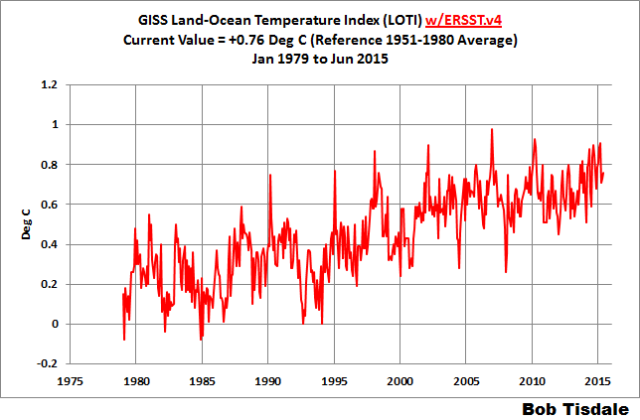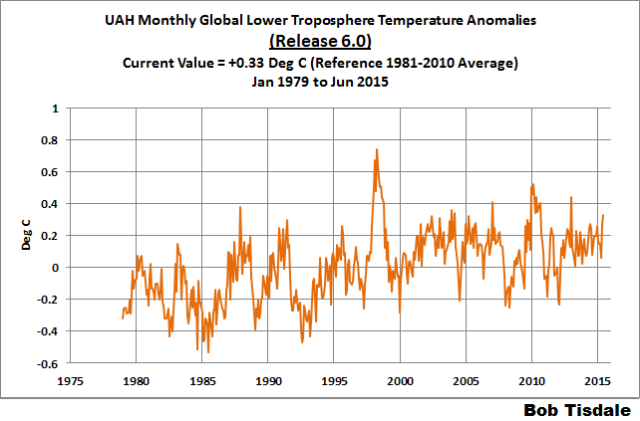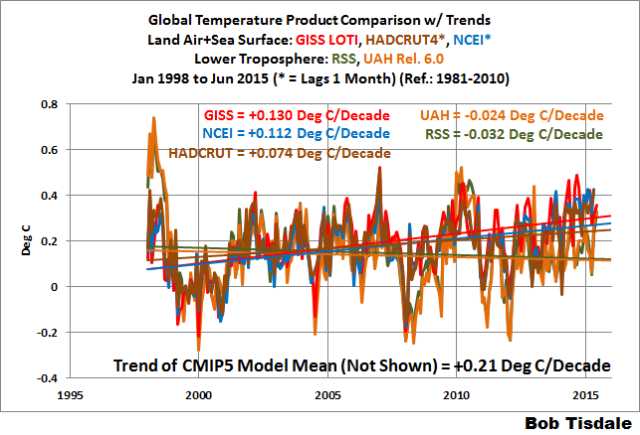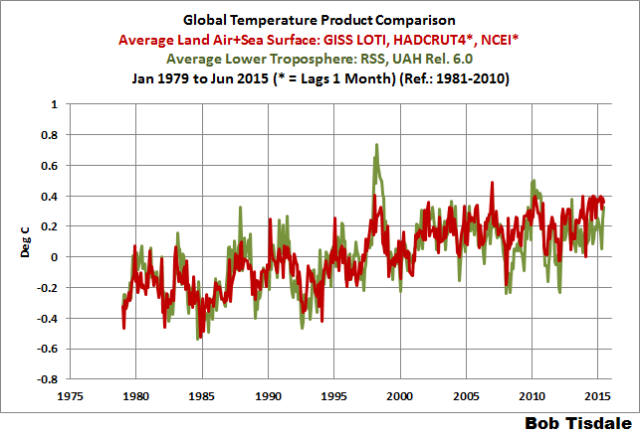This is the June 2015 Global Surface (Land+Ocean) and Lower Troposphere Temperature Anomaly & Model-Data Difference Update, but in it we’re presenting the new GISS and NCEI surface temperature products…and the UAH lower troposphere temperature data version 6.
This post provides an update of the products of the three primary suppliers of global land+ocean surface temperature data—GISS through June 2015 and HADCRUT4 and NCEI (formerly NCDC) through May 2015—and of the two suppliers of satellite-based lower troposphere temperature data (RSS and UAH) through June 2015. It also includes a model-data comparison.
We’ll take a look at the impacts of those changes to the GISS and NCEI products in much more detail in a future blog post. If you’d like to compare trends before and after the switch, see the May update. I’ll show the befores and afters on graphs in that future post.
INITIAL NOTES:
The NCEI data is the new global land+ocean surface product with the unjustifiable, overcooked adjustments presented in Karl et al. (2015).
Even though the changes to the ERSST data since 1998 cannot be justified by the night marine air temperature dataset that was used as a reference for bias adjustments (See comparison graph here), GISS also switched to the new “pause-buster” NCEI ERSST.v4 sea surface temperature data with their June 2015 update to their Land-Ocean Temperature Index product. (Also see the above-linked post.) The GISS July 15 announcement on their Updates to Analysis page reads (my boldface):
July 15, 2015: Starting with today’s update, the standard GISS analysis is no longer based on ERSST v3b but on the newer ERSST v4. Dr. Makiko Sato created some graphs and maps showing the effect of that change. More information may be obtained from NOAA’s website. Furthermore, we eliminated GHCN’s Amundsen-Scott temperature series using just the SCAR reports for the South Pole.
Release 5.6 of the UAH lower troposphere temperature anomalies had not yet been updated by the time I prepared this post, so I’ve used the new Release 6.0 even though it’s in beta form.
GISS LOTI surface data, and the two lower troposphere temperature datasets are for the most recent month. The HADCRUT4 and NCEI data lag one month.
Much of the following text is boilerplate…updated for the NCEI and GISS data. It is intended for those new to the presentation of global surface temperature anomaly data.
Most of the update graphs start in 1979. That’s a commonly used start year for global temperature products because many of the satellite-based temperature datasets start then.
We discussed why the three suppliers of surface temperature data use different base years for anomalies in the post Why Aren’t Global Surface Temperature Data Produced in Absolute Form?
In recent posts, we’ve used the GISS LOTI data for the model-data comparisons. From this post forward, we’re using the UKMO’s HadCRUT4 data.
GISS LAND OCEAN TEMPERATURE INDEX (LOTI)
Introduction: The GISS Land Ocean Temperature Index (LOTI) data is a product of the Goddard Institute for Space Studies. Starting with the June 2015 update, GISS LOTI uses the new NOAA Extended Reconstructed Sea Surface Temperature version 4 (ERSST.v4), the pause-buster data. GISS adjusts GHCN and other land surface temperature data via a number of methods and infills missing data using 1200km smoothing. Refer to the GISS description here. Unlike the UK Met Office and NCEI products, GISS masks sea surface temperature data at the poles where seasonal sea ice exists, and they extend land surface temperature data out over the oceans in those locations. Refer to the discussions here and here. GISS uses the base years of 1951-1980 as the reference period for anomalies. The data source is here. (I archived the former version here at the WaybackMachine.)
Update: The June 2015 GISS global temperature anomaly is +0.76 deg C. It rose (an increase of about +0.03 deg C) since May 2015 (based on the new data).
Figure 1 – GISS Land-Ocean Temperature Index
NCEI GLOBAL SURFACE TEMPERATURE ANOMALIES (LAGS ONE MONTH)
NOTE: The NCEI has published the data associated with the unjustifiably overcooked “pause busting” adjustments presented in the paper Karl et al. (2015). As far as I know, the former version of the data is no longer available online. For more information on those curious adjustments, see the posts:
- NOAA/NCDC’s new ‘pause-buster’ paper: a laughable attempt to create warming by adjusting past data
- More Curiosities about NOAA’s New “Pause Busting” Sea Surface Temperature Dataset
- Open Letter to Tom Karl of NOAA/NCEI Regarding “Hiatus Busting” Paper
- NOAA Releases New Pause-Buster Global Surface Temperature Data and Immediately Claims Record-High Temps for May 2015 – What a Surprise!
Introduction: The NOAA Global (Land and Ocean) Surface Temperature Anomaly dataset is a product of the National Centers for Environmental Information (NCEI), which was formerly known as the National Climatic Data Center (NCDC). NCEI merges their new Extended Reconstructed Sea Surface Temperature version 4 (ERSST.v4) with the new Global Historical Climatology Network-Monthly (GHCN-M) version 3.3.0 for land surface air temperatures.
The NCEI data source is through their Global Surface Temperature Anomalies webpage. Click on the link to Anomalies and Index Data.)
Update (Lags One Month): The May 2015 NCEI global land plus sea surface temperature anomaly was +0.87 deg C. See Figure 2. It rose (an increase of +0.08 deg C) since April 2015 (based on the new data).
Figure 2 – NCEI Global (Land and Ocean) Surface Temperature Anomalies
UK MET OFFICE HADCRUT4 (LAGS ONE MONTH)
Introduction: The UK Met Office HADCRUT4 dataset merges CRUTEM4 land-surface air temperature dataset and the HadSST3 sea-surface temperature (SST) dataset. CRUTEM4 is the product of the combined efforts of the Met Office Hadley Centre and the Climatic Research Unit at the University of East Anglia. And HadSST3 is a product of the Hadley Centre. Unlike the GISS and NCEI products, grids with missing data are not infilled in the HADCRUT4 product. That is, if a 5-deg latitude by 5-deg longitude grid does not have a temperature anomaly value in a given month, it is not included in the global average value of HADCRUT4. The HADCRUT4 dataset is described in the Morice et al (2012) paper here. The CRUTEM4 data is described in Jones et al (2012) here. And the HadSST3 data is presented in the 2-part Kennedy et al (2012) paper here and here. The UKMO uses the base years of 1961-1990 for anomalies. The data source is here.
Update (Lags One Month): The May 2015 HADCRUT4 global temperature anomaly is +0.69 deg C. See Figure 3. It increased (about +0.04 deg C) since April 2015.
Figure 3 – HADCRUT4
UAH LOWER TROPOSPHERE TEMPERATURE ANOMALY DATA (UAH TLT)
Special sensors (microwave sounding units) aboard satellites have orbited the Earth since the late 1970s, allowing scientists to calculate the temperatures of the atmosphere at various heights above sea level. The level nearest to the surface of the Earth is the lower troposphere. The lower troposphere temperature data include the altitudes of zero to about 12,500 meters, but are most heavily weighted to the altitudes of less than 3000 meters. See the left-hand cell of the illustration here. The lower troposphere temperature data are calculated from a series of satellites with overlapping operation periods, not from a single satellite. The monthly UAH lower troposphere temperature data is the product of the Earth System Science Center of the University of Alabama in Huntsville (UAH). UAH provides the data broken down into numerous subsets. See the webpage here. The UAH lower troposphere temperature data are supported by Christy et al. (2000) MSU Tropospheric Temperatures: Dataset Construction and Radiosonde Comparisons. Additionally, Dr. Roy Spencer of UAH presents at his blog the monthly UAH TLT data updates a few days before the release at the UAH website. Those posts are also cross posted at WattsUpWithThat. UAH uses the base years of 1981-2010 for anomalies. The UAH lower troposphere temperature data are for the latitudes of 85S to 85N, which represent more than 99% of the surface of the globe.
UAH recently released a beta version of Release 6.0 of their atmospheric temperature data. Those enhancements lowered the warming rates of their lower troposphere temperature data. See Dr. Roy Spencer’s blog post Version 6.0 of the UAH Temperature Dataset Released: New LT Trend = +0.11 C/decade and my blog post New UAH Lower Troposphere Temperature Data Show No Global Warming for More Than 18 Years. The UAH lower troposphere Release 6.0 beta data through June 2015 are here.
Update: The June 2015 UAH (Release 6.0 beta) lower troposphere temperature anomaly is +0.33 deg C. It rose (an increase of about +0.06 deg C) since May 2015.
Figure 4 – UAH Lower Troposphere Temperature (TLT) Anomaly Data – Release 6.0 Beta
RSS LOWER TROPOSPHERE TEMPERATURE ANOMALY DATA (RSS TLT)
Like the UAH lower troposphere temperature data, Remote Sensing Systems (RSS) calculates lower troposphere temperature anomalies from microwave sounding units aboard a series of NOAA satellites. RSS describes their data at the Upper Air Temperature webpage. The RSS data are supported by Mears and Wentz (2009) Construction of the Remote Sensing Systems V3.2 Atmospheric Temperature Records from the MSU and AMSU Microwave Sounders. RSS also presents their lower troposphere temperature data in various subsets. The land+ocean TLT data are here. Curiously, on that webpage, RSS lists the data as extending from 82.5S to 82.5N, while on their Upper Air Temperature webpage linked above, they state:
We do not provide monthly means poleward of 82.5 degrees (or south of 70S for TLT) due to difficulties in merging measurements in these regions.
Also see the RSS MSU & AMSU Time Series Trend Browse Tool. RSS uses the base years of 1979 to 1998 for anomalies.
Update: The June 2015 RSS lower troposphere temperature anomaly is +0.39 deg C. It rose (an increase of about +0.08 deg C) since May 2015.
Figure 5 – RSS Lower Troposphere Temperature (TLT) Anomaly Data
COMPARISONS
The GISS, HADCRUT4 and NCEI global surface temperature anomalies and the RSS and UAH lower troposphere temperature anomalies are compared in the next three time-series graphs. Figure 6 compares the five global temperature anomaly products starting in 1979. Again, due to the timing of this post, the HADCRUT4 and NCEI data lag the UAH, RSS and GISS products by a month. For those wanting a closer look at the more recent wiggles and trends, Figure 7 starts in 1998, which was the start year used by von Storch et al (2013) Can climate models explain the recent stagnation in global warming? They, of course, found that the CMIP3 (IPCC AR4) and CMIP5 (IPCC AR5) models could NOT explain the recent halt in warming.
Figure 8 starts in 2001, which was the year Kevin Trenberth chose for the start of the warming halt in his RMS article Has Global Warming Stalled?
Because the suppliers all use different base years for calculating anomalies, I’ve referenced them to a common 30-year period: 1981 to 2010. Referring to their discussion under FAQ 9 here, according to NOAA:
This period is used in order to comply with a recommended World Meteorological Organization (WMO) Policy, which suggests using the latest decade for the 30-year average.
The impacts of the unjustifiable adjustments to the ERSST.v4 data are visible in the two shorter-term comparisons, Figures 7 and 8. That is, the short-term warming rates of the new NCEI and GISS data are noticeably higher during “the hiatus”. The GISS and NCEI products now more than double the HADCRUT4 warming rate since 2001. Also see the comparisons in the May update for the former trends of the GISS and NCEI products. Even with the new pause-buster sea surface temperature data, the GISS and NCEI products still fall short of the modeled warming rates.
Figure 6 – Comparison Starting in 1979
###########
Figure 7 – Comparison Starting in 1998
###########
Figure 8 – Comparison Starting in 2001
Note: the graphs list the trends of the CMIP5 multi-model mean (historic and RCP8.5 forcings), which are the climate models used by the IPCC for their 5th Assessment Report.
AVERAGE
Figure 9 presents the average of the GISS, HADCRUT and NCEI land plus sea surface temperature anomaly products and the average of the RSS and UAH lower troposphere temperature data. Again because the HADCRUT4 and NCEI data lag one month in this update, the most current average only includes the GISS product.
Figure 9 – Average of Global Land+Sea Surface Temperature Anomaly Products
MODEL-DATA COMPARISON & DIFFERENCE
Note: I used to use the GISS LOTI data in this section, but I’ve switched to the HADCRUT4 data. I’ll present the model-data comparisons and model-data differences using the GISS and NCEI products (before and after the switch to pause-buster data) in a future post. [End note.]
Considering the uptick in surface temperatures this year (see the posts here and here), government agencies that supply global surface temperature products have been touting record high combined global land and ocean surface temperatures. Alarmists happily ignore the fact that it is easy to have record high global temperatures in the midst of a hiatus or slowdown in global warming, and they have been using the recent record highs to draw attention away from the growing difference between observed global surface temperatures and the IPCC climate model-based projections of them.
There are a number of ways to present how poorly climate models simulate global surface temperatures. Normally they are compared in a time-series graph. See the example in Figure 10. In that example, the UKMO HadCRUT4 land+ocean surface temperature data are compared to the multi-model mean of the climate models stored in the CMIP5 archive, which was used by the IPCC for their 5th Assessment Report. The data and model outputs have been smoothed with 61-month filters to reduce the monthly variations. Also, the anomalies for the data and model outputs have been referenced to the period of 1880 to 2013 so not to bias the results.
It’s very hard to overlook the fact that, over the past decade, climate models are simulating way too much warming and are diverging rapidly from reality.
Another way to show how poorly climate models perform is to subtract the data from the average of the model outputs (model mean). We first presented and discussed this method using global surface temperatures in absolute form. (See the post On the Elusive Absolute Global Mean Surface Temperature – A Model-Data Comparison.) The graph below shows a model-data difference using anomalies, where the data are represented by the UKMO HadCRUT4 land+ocean surface temperature data and the model simulations of global surface temperature are represented by the multi-model mean of the models stored in the CMIP5 archive. Like Figure 10, to assure that the base years used for anomalies did not bias the graph, the near full term of the data (1880 to 2013) were used as the reference period.
In this example, we’re illustrating the model-data differences in the monthly surface temperature anomalies. Also included in red is the difference smoothed with a 61-month running mean filter.
Figure 11
The greatest difference between models and data occurs now.
There was also a major difference, but of the opposite sign, in the late 1880s. That difference decreases drastically from the 1880s and switches signs by the 1910s. The reason: the models do not properly simulate the observed cooling that takes place at that time. Because the models failed to properly simulate the cooling from the 1880s to the 1910s, they also failed to properly simulate the warming that took place from the 1910s until 1940. That explains the long-term decrease in the difference during that period and the switching of signs in the difference once again. The difference cycles back and forth, nearing a zero difference in the 1980s and 90s, indicating the models are tracking observations better (relatively) during that period. And from the 1990s to present, because of the slowdown in warming, the difference has increased to greatest value ever…where the difference indicates the models are showing too much warming.
It’s very easy to see the recent record-high global surface temperatures have had a tiny impact on the difference between models and observations.
See the post On the Use of the Multi-Model Mean for a discussion of its use in model-data comparisons.
MONTHLY SEA SURFACE TEMPERATURE UPDATE
The most recent sea surface temperature update can be found here. The satellite-enhanced sea surface temperature data (Reynolds OI.2) are presented in global, hemispheric and ocean-basin bases. We discussed the recent record-high global sea surface temperatures and the reasons for them in the post On The Recent Record-High Global Sea Surface Temperatures – The Wheres and Whys.














You CANNOT be surprised that they jump on the “Karl et al” bandwagon with the alacrity of a starving kid let loose in a candy store.
I mean, isn’t the “warmest year ever” drivel supposed to come out prior to Paris???
Didn’t have too much for dinner tonight, so the food should stay down – but its trying to come up!
Reblogged this on Centinel2012 and commented:
A bit technical for the average person but the summary is that the IPCC climate models as shown in Figure 10 are now showing that global temperatures should be SIGNIFICANTLY higher than what NOAA and NASA show. The importance of Bob’s work is that the powers to be are making current temperatures unjustly higher than they should be and that even with that there are no even close to what the IPCC climate models say they should be.
Bob’s work is much more complete than the simple model I developed but the results are the same.
Calling it the Unjustifiably Overcooked “Pause-Busting” Sea Surface Temperature Dataset is clumsy. Why not shorten the name to say what it really is — the NOAA Contaminated SST dataset? Adjusting relatively better data to poorer quality data is nothing if not contamination.
Pingback: The Three Faces of the GISS Land Ocean Temperature Index (LOTI) | Bob Tisdale – Climate Observations
Pingback: The Three Faces of the GISS Land-Ocean Temperature Index (LOTI) | Watts Up With That?
Pingback: The Three Faces of the GISS Land-Ocean Temperature Index (LOTI) | I World New
Pingback: Fundamental Differences between the NOAA and UAH Global Temperature Updates | Bob Tisdale – Climate Observations
Pingback: Fundamental Differences between the NOAA and UAH Global Temperature Updates | Watts Up With That?
Pingback: Paris World Summit of Conscience, International interfaith gathering #2 | Marcus Ampe's Space
Pingback: July 2015 Global Surface (Land+Ocean) and Lower Troposphere Temperature Anomaly & Model-Data Difference Update | Bob Tisdale – Climate Observations
Pingback: July 2015 Global Surface (Land+Ocean) and Lower Troposphere Temperature Anomaly & Model-Data Difference Update | Watts Up With That?
Pingback: July 2015 Global Surface (Land+Ocean) and Lower Troposphere Temperature Anomaly & Model-Data Difference Update | US Issues
Pingback: August 2015 Global Surface (Land+Ocean) and Lower Troposphere Temperature Anomaly & Model-Data Difference Update | Bob Tisdale – Climate Observations
Pingback: August 2015 Global Surface (Land+Ocean) and Lower Troposphere Temperature Anomaly & Model-Data Difference Update | Watts Up With That?
Pingback: September 2015 Global Surface (Land+Ocean) and Lower Troposphere Temperature Anomaly & Model-Data Difference Update | Bob Tisdale – Climate Observations
Pingback: September 2015 Global Surface (Land+Ocean) and Lower Troposphere Temperature Anomaly & Model-Data Difference Update | Watts Up With That?
Pingback: October 2015 Global Surface (Land+Ocean) and Lower Troposphere Temperature Anomaly & Model-Data Difference Update | Bob Tisdale – Climate Observations
Pingback: October 2015 Global Surface (Land+Ocean) and Lower Troposphere Temperature Anomaly & Model-Data Difference Update | Watts Up With That?
Pingback: November 2015 Global Surface (Land+Ocean) and Lower Troposphere Temperature Anomaly & Model-Data Difference Update. | Bob Tisdale – Climate Observations
Pingback: November 2015 Global Surface (Land+Ocean) and Lower Troposphere Temperature Anomaly & Model-Data Difference Update | Watts Up With That?
Pingback: January 2016 Global Surface (Land+Ocean) and Lower Troposphere Temperature Anomaly Update | Bob Tisdale – Climate Observations
Pingback: January 2016 Global Surface (Land+Ocean) and Lower Troposphere Temperature Anomaly Update | Watts Up With That?
Pingback: February 2016 Global Surface (Land+Ocean) and Lower Troposphere Temperature Anomaly Update | Bob Tisdale – Climate Observations
Pingback: February 2016 Global Surface (Land+Ocean) and Lower Troposphere Temperature Anomaly Update | Watts Up With That?
Pingback: February 2016 Global Temperature Update | The Global Warming Policy Forum (GWPF)
Pingback: March 2016 Global Surface (Land+Ocean) and Lower Troposphere Temperature Anomaly Update | Bob Tisdale – Climate Observations
Pingback: March 2016 Global Surface (Land+Ocean) and Lower Troposphere Temperature Anomaly Update | Watts Up With That?
Pingback: April 2016 Global Surface (Land+Ocean) and Lower Troposphere Temperature Anomaly Update | Bob Tisdale – Climate Observations
Pingback: April 2016 Global Surface (Land+Ocean) and Lower Troposphere Temperature Anomaly Update | Watts Up With That?
Pingback: May 2016 Global Surface (Land+Ocean) and Lower Troposphere Temperature Anomaly Update | Bob Tisdale – Climate Observations
Pingback: May 2016 Global Surface (Land+Ocean) and Lower Troposphere Temperature Anomaly Update | Watts Up With That?
Pingback: June 2016 Global Surface (Land+Ocean) and Lower Troposphere Temperature Anomaly Update | Bob Tisdale – Climate Observations
Pingback: June 2016 Global Surface (Land+Ocean) and Lower Troposphere Temperature Anomaly Update | Watts Up With That?
Pingback: July 2016 Global Surface (Land+Ocean) and Lower Troposphere Temperature Anomaly Update | Bob Tisdale – Climate Observations
Pingback: July 2016 Global Surface (Land+Ocean) and Lower Troposphere Temperature Anomaly Update | Watts Up With That?
Pingback: August 2016 Global Surface (Land+Ocean) and Lower Troposphere Temperature Anomaly Update | Bob Tisdale – Climate Observations
Pingback: August 2016 Global Surface (Land+Ocean) and Lower Troposphere Temperature Anomaly Update | Watts Up With That?
Pingback: September 2016 Global Surface (Land+Ocean) and Lower Troposphere Temperature Anomaly Update | Bob Tisdale – Climate Observations
Pingback: September 2016 Global Surface (Land+Ocean) and Lower Troposphere Temperature Anomaly Update | Watts Up With That?
Pingback: October 2016 Global Surface (Land+Ocean) and Lower Troposphere Temperature Anomaly Update | Bob Tisdale – Climate Observations
Pingback: October 2016 Global Surface (Land+Ocean) and Lower Troposphere Temperature Anomaly Update | Watts Up With That?
Pingback: November 2016 Global Surface (Land+Ocean) and Lower Troposphere Temperature Anomaly Update | Bob Tisdale – Climate Observations
Pingback: November 2016 Global Surface (Land+Ocean) and Lower Troposphere Temperature Anomaly Update | Watts Up With That?
Pingback: December 2016 Global Surface (Land+Ocean) and Lower Troposphere Temperature Anomaly Update – With a Look at the Year-End Annual Results | Bob Tisdale – Climate Observations
Pingback: December 2016 Global Surface (Land+Ocean) and Lower Troposphere Temperature Anomaly Update – With a Look at the Year-End Annual Results | Watts Up With That?